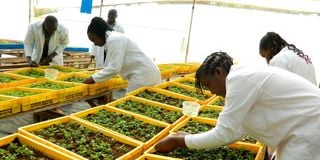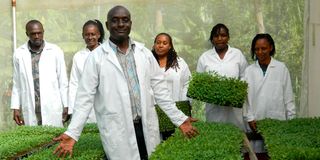Premium
New technology accelerates potato seed production

Paul Munene with part of his staff at his Rukaria Potato Farm on the outskirts of Nkubu town, Meru County on December 7, 2024. The farm specialises in propagating certified apical rooted potato cuttings.
What you need to know:
- Potato is the second-most important food in the country after maize and third globally.
- Despite this, production volumes have either been dwindling or stagnating over the years.
Some four kilometres from Nkubu town in Nkuene ward, Kathera sub-location, is Rukaria Potato Farm. The farm specialises in propagating certified apical rooted potato cuttings in a greenhouse where they produce up to 5,000 cuttings a day on order.
Paul Munene, a lead farmer and a trained seed multiplier, embraced the apical rooted cuttings (ARC) technology in 2018 after being trained on potato quality improvement. He says that the technology boosts potato yields by lessening crop loss and disease.
According to Munene, the technology allows farmers get certified seeds locally. He says that the average yield per farmer has been ranging between six and 10 tonnes per hectare, yet healthy varieties can produce up to four times more.
The importance of potatoes in Kenya and the world is immense; it is the second-most important food in the country after maize and third globally after rice and wheat.
“In Kenya potato is not just a dietary food that is rich in protein, calcium, potassium and vitamins, but it is also considered critical, especially in driving the smallholder economy, which accounts for approximately 800,000 farmers,” he says.
Despite this, production volumes have either been dwindling or stagnating over the years, yet the adaptability of potatoes in Kenya makes them ideal for growing in different agro-ecological zones across the country.
To promote technologies that accelerate seed production and enhance farmers access to high quality seeds, Munene has been using ARC, a technology that uses a cutting similar to a nursery grown seedling, with the only difference being that it is produced vegetatively, meaning that it does not originate from a seed.
“The cuttings are produced from tissue culture plantlets in a screen house instead of being produced from mini tubers, and after they root, they are planted in the open field,” says Miriam Kinyua a professor in the department of biotechnology at the University of Eldoret.
The cuttings stay in a screen house for about 2-3 weeks to develop proper roots before transplanting. Each cutting, which is disease free, has capacity to produce up to 24 tubers that can be multiplied in subsequent seasons to produce high quality seeds.

Paul Munene with part of his staff at his Rukaria Potato Farm on the outskirts of Nkubu town, Meru County on December 7, 2024.
The cuttings are then sold as seedlings, which makes it easy for farmers to access quality certified seeds in a short span of time.
Further, the cuttings are not at risk of diseases even after producing several cuttings from the mother plant, a challenge most potato farmers have previously faced.
“The ARC technology has thus contributed significantly to the increased supply of certified high-quality seeds as farmers are assured of very high returns. The mother plant can be used to produce apical cuttings for at least three months before being disposed, making it a sure way of producing certified potatoes throughout the year,” Kinyua adds.
One tissue culture plantlet can produce over 100 cuttings and in turn 1,000 to 2,000 first generation field multiplications as compared to traditional systems where one tissue culture plantlet produces 10 to 50 mini-tubers.
“The varieties thus offer superior yields that are resistant to diseases,” Dan Mwathi, an agronomist at the farm, says.
During planting, Mwathi says, the land should be well prepared with a normal spacing, with the best spacing being 1.5ft by1ft. This is followed by making furrows of at least 3-5 inches depth.
“With the cuttings we first do seed bulking to have enough seeds to plant in a large area after which we start selling as ware potatoes. Planting 1000pcs of cuttings can produces tubers enough to plant on one acre of land,” he says.
Mwathi advises farmers to make their own seeds by embracing the use of ARC and warns them against planting cuttings in already infected areas or on farms affected by bacteria wilt.
“The apical rooted cuttings mature faster than the seed potato tuber. Another advantage that comes with the apical rooted cuttings technology is that farmers can grow the cuttings at any time within the year, unlike tubers that are seasonal,” he adds.





